Journal Entry: Leading and Managing Organizational Changes Reflection
VerifiedAdded on 2023/01/17
|8
|1517
|34
Journal and Reflective Writing
AI Summary
This reflective journal entry details a student's experience as a finance manager in the BCPC Internet Strategy team, tasked with recommending whether BCPC should adopt the High-speed Internet-access Product (HIP). The journal reflects on the importance of cost-benefit analysis, teamwork, and leadership in managing organizational change. It highlights the significance of democratic leadership, open communication, and addressing team members' perceptions and fears regarding change. The author emphasizes the value of inclusive leadership in fostering cooperation and collaboration, leading to a productive team environment. The reflection concludes with recommendations for leaders to adopt democratic leadership styles, and to motivate and inspire team members during organizational change.
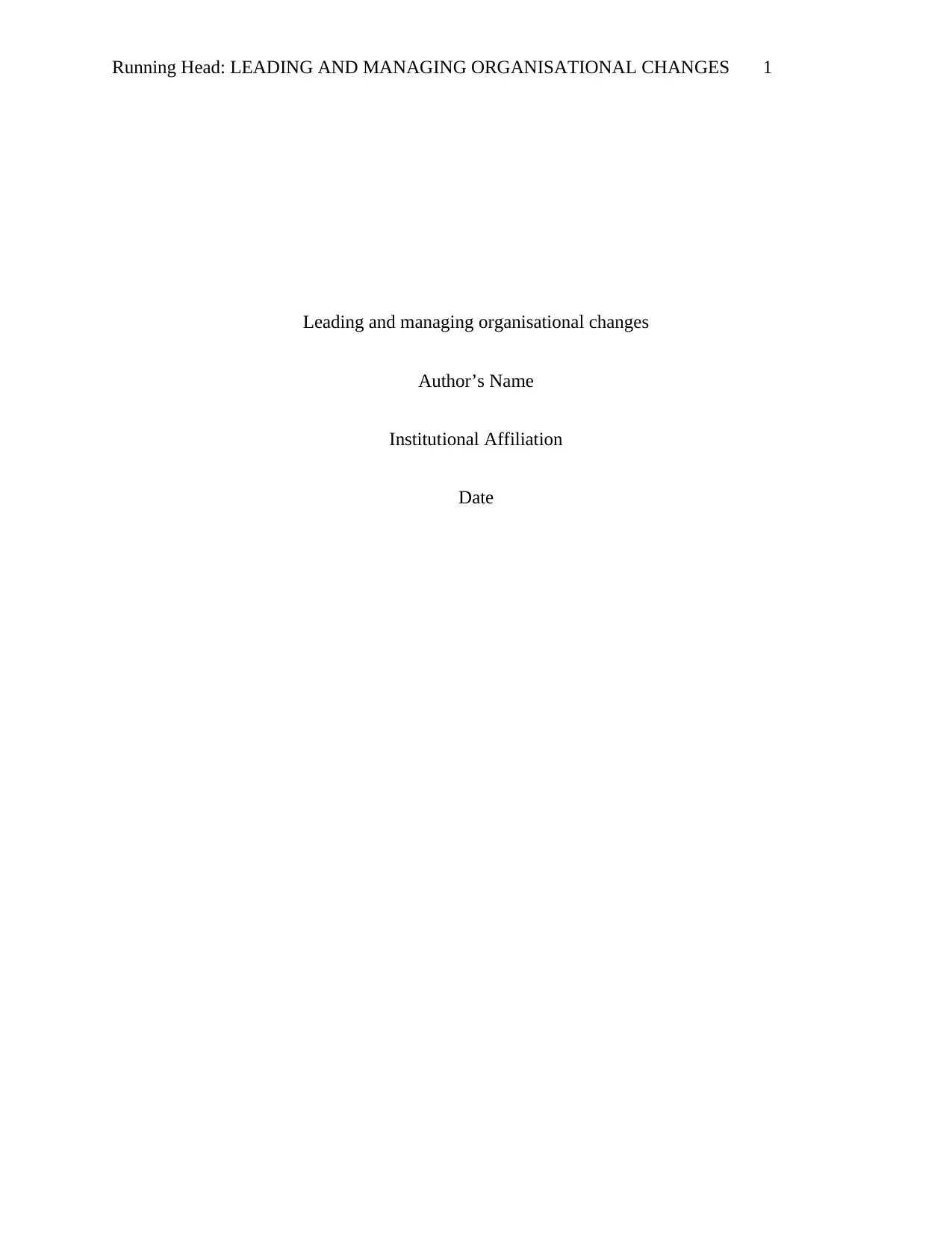
Running Head: LEADING AND MANAGING ORGANISATIONAL CHANGES 1
Leading and managing organisational changes
Author’s Name
Institutional Affiliation
Date
Leading and managing organisational changes
Author’s Name
Institutional Affiliation
Date
Paraphrase This Document
Need a fresh take? Get an instant paraphrase of this document with our AI Paraphraser
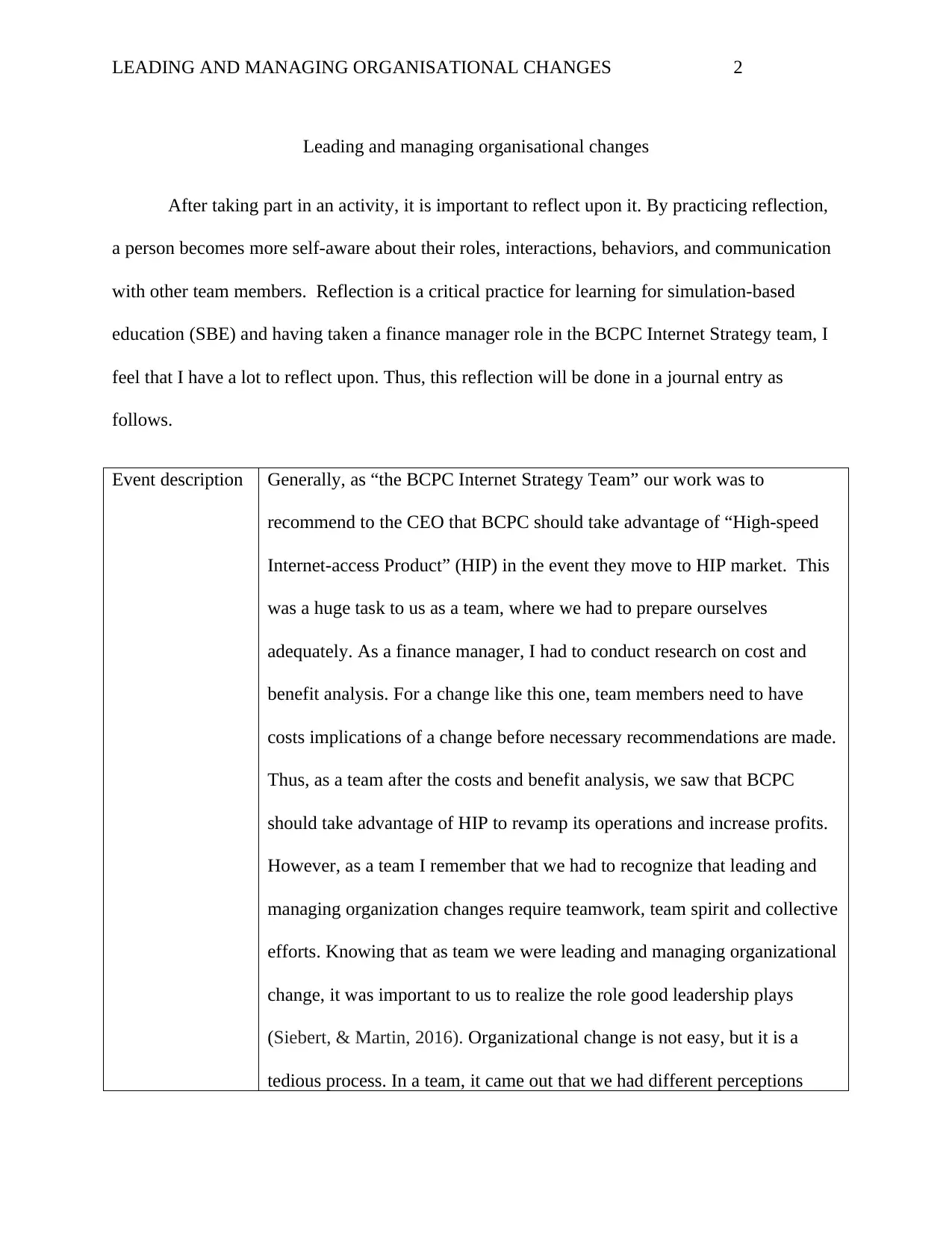
LEADING AND MANAGING ORGANISATIONAL CHANGES 2
Leading and managing organisational changes
After taking part in an activity, it is important to reflect upon it. By practicing reflection,
a person becomes more self-aware about their roles, interactions, behaviors, and communication
with other team members. Reflection is a critical practice for learning for simulation-based
education (SBE) and having taken a finance manager role in the BCPC Internet Strategy team, I
feel that I have a lot to reflect upon. Thus, this reflection will be done in a journal entry as
follows.
Event description Generally, as “the BCPC Internet Strategy Team” our work was to
recommend to the CEO that BCPC should take advantage of “High-speed
Internet-access Product” (HIP) in the event they move to HIP market. This
was a huge task to us as a team, where we had to prepare ourselves
adequately. As a finance manager, I had to conduct research on cost and
benefit analysis. For a change like this one, team members need to have
costs implications of a change before necessary recommendations are made.
Thus, as a team after the costs and benefit analysis, we saw that BCPC
should take advantage of HIP to revamp its operations and increase profits.
However, as a team I remember that we had to recognize that leading and
managing organization changes require teamwork, team spirit and collective
efforts. Knowing that as team we were leading and managing organizational
change, it was important to us to realize the role good leadership plays
(Siebert, & Martin, 2016). Organizational change is not easy, but it is a
tedious process. In a team, it came out that we had different perceptions
Leading and managing organisational changes
After taking part in an activity, it is important to reflect upon it. By practicing reflection,
a person becomes more self-aware about their roles, interactions, behaviors, and communication
with other team members. Reflection is a critical practice for learning for simulation-based
education (SBE) and having taken a finance manager role in the BCPC Internet Strategy team, I
feel that I have a lot to reflect upon. Thus, this reflection will be done in a journal entry as
follows.
Event description Generally, as “the BCPC Internet Strategy Team” our work was to
recommend to the CEO that BCPC should take advantage of “High-speed
Internet-access Product” (HIP) in the event they move to HIP market. This
was a huge task to us as a team, where we had to prepare ourselves
adequately. As a finance manager, I had to conduct research on cost and
benefit analysis. For a change like this one, team members need to have
costs implications of a change before necessary recommendations are made.
Thus, as a team after the costs and benefit analysis, we saw that BCPC
should take advantage of HIP to revamp its operations and increase profits.
However, as a team I remember that we had to recognize that leading and
managing organization changes require teamwork, team spirit and collective
efforts. Knowing that as team we were leading and managing organizational
change, it was important to us to realize the role good leadership plays
(Siebert, & Martin, 2016). Organizational change is not easy, but it is a
tedious process. In a team, it came out that we had different perceptions
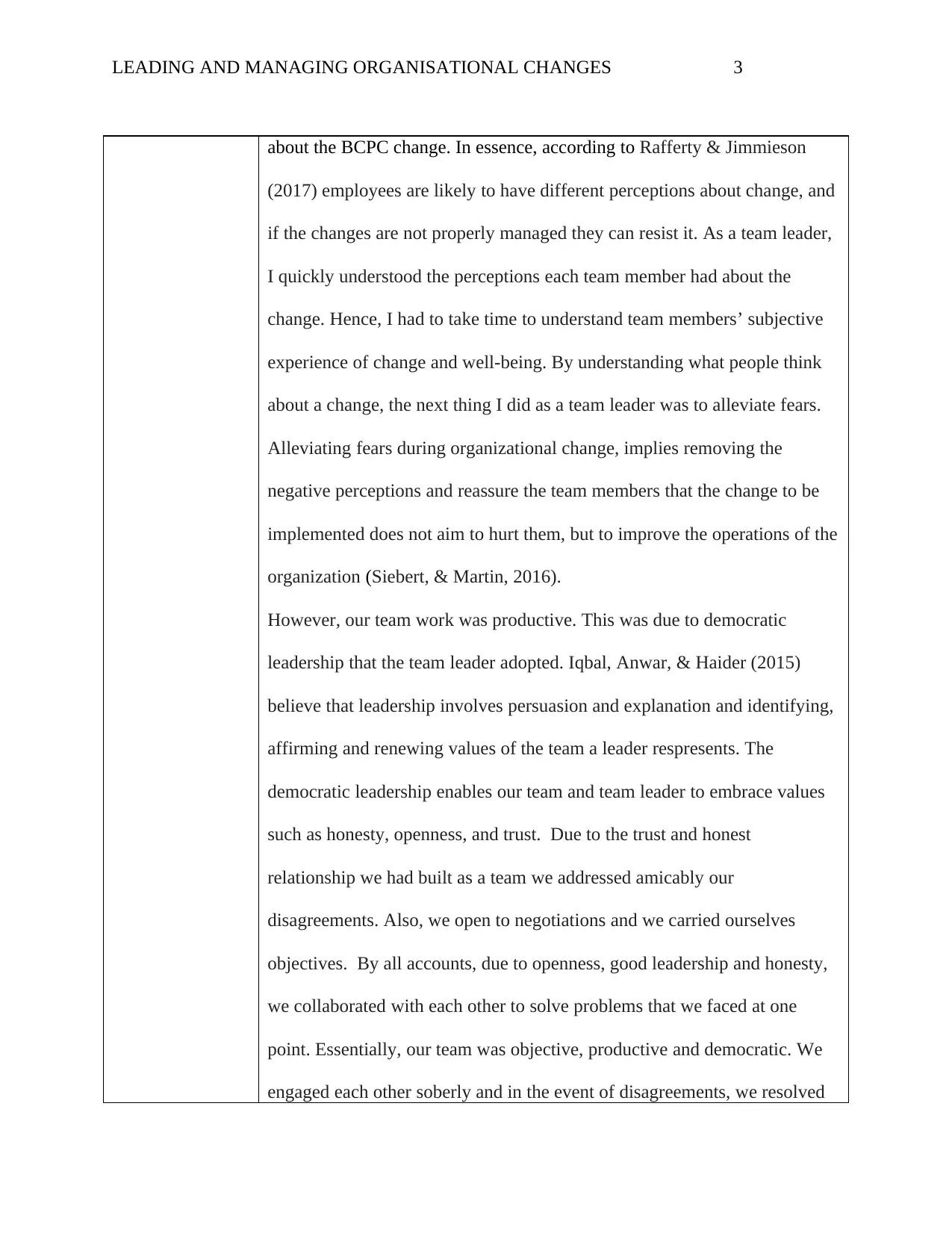
LEADING AND MANAGING ORGANISATIONAL CHANGES 3
about the BCPC change. In essence, according to Rafferty & Jimmieson
(2017) employees are likely to have different perceptions about change, and
if the changes are not properly managed they can resist it. As a team leader,
I quickly understood the perceptions each team member had about the
change. Hence, I had to take time to understand team members’ subjective
experience of change and well-being. By understanding what people think
about a change, the next thing I did as a team leader was to alleviate fears.
Alleviating fears during organizational change, implies removing the
negative perceptions and reassure the team members that the change to be
implemented does not aim to hurt them, but to improve the operations of the
organization (Siebert, & Martin, 2016).
However, our team work was productive. This was due to democratic
leadership that the team leader adopted. Iqbal, Anwar, & Haider (2015)
believe that leadership involves persuasion and explanation and identifying,
affirming and renewing values of the team a leader respresents. The
democratic leadership enables our team and team leader to embrace values
such as honesty, openness, and trust. Due to the trust and honest
relationship we had built as a team we addressed amicably our
disagreements. Also, we open to negotiations and we carried ourselves
objectives. By all accounts, due to openness, good leadership and honesty,
we collaborated with each other to solve problems that we faced at one
point. Essentially, our team was objective, productive and democratic. We
engaged each other soberly and in the event of disagreements, we resolved
about the BCPC change. In essence, according to Rafferty & Jimmieson
(2017) employees are likely to have different perceptions about change, and
if the changes are not properly managed they can resist it. As a team leader,
I quickly understood the perceptions each team member had about the
change. Hence, I had to take time to understand team members’ subjective
experience of change and well-being. By understanding what people think
about a change, the next thing I did as a team leader was to alleviate fears.
Alleviating fears during organizational change, implies removing the
negative perceptions and reassure the team members that the change to be
implemented does not aim to hurt them, but to improve the operations of the
organization (Siebert, & Martin, 2016).
However, our team work was productive. This was due to democratic
leadership that the team leader adopted. Iqbal, Anwar, & Haider (2015)
believe that leadership involves persuasion and explanation and identifying,
affirming and renewing values of the team a leader respresents. The
democratic leadership enables our team and team leader to embrace values
such as honesty, openness, and trust. Due to the trust and honest
relationship we had built as a team we addressed amicably our
disagreements. Also, we open to negotiations and we carried ourselves
objectives. By all accounts, due to openness, good leadership and honesty,
we collaborated with each other to solve problems that we faced at one
point. Essentially, our team was objective, productive and democratic. We
engaged each other soberly and in the event of disagreements, we resolved
⊘ This is a preview!⊘
Do you want full access?
Subscribe today to unlock all pages.

Trusted by 1+ million students worldwide
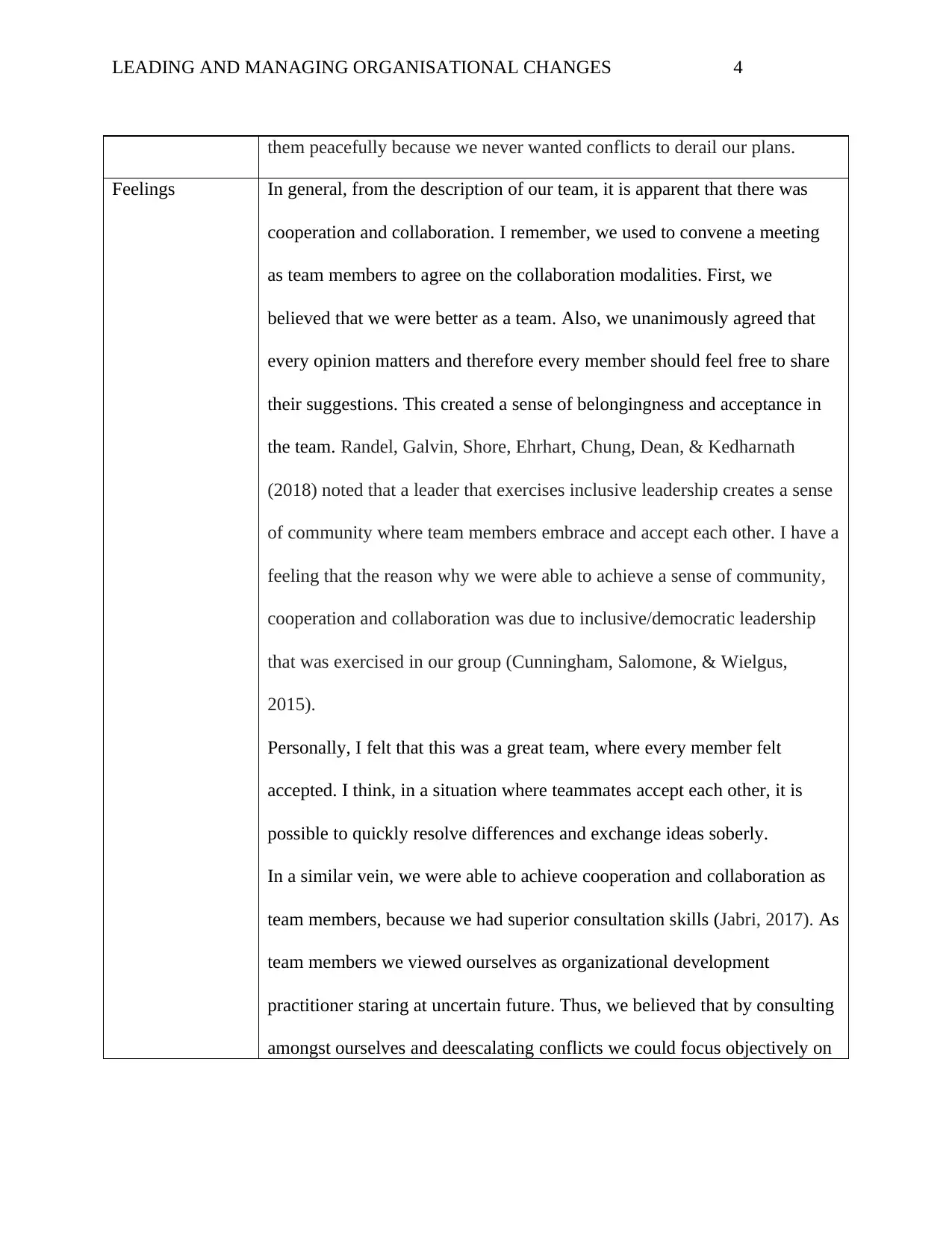
LEADING AND MANAGING ORGANISATIONAL CHANGES 4
them peacefully because we never wanted conflicts to derail our plans.
Feelings In general, from the description of our team, it is apparent that there was
cooperation and collaboration. I remember, we used to convene a meeting
as team members to agree on the collaboration modalities. First, we
believed that we were better as a team. Also, we unanimously agreed that
every opinion matters and therefore every member should feel free to share
their suggestions. This created a sense of belongingness and acceptance in
the team. Randel, Galvin, Shore, Ehrhart, Chung, Dean, & Kedharnath
(2018) noted that a leader that exercises inclusive leadership creates a sense
of community where team members embrace and accept each other. I have a
feeling that the reason why we were able to achieve a sense of community,
cooperation and collaboration was due to inclusive/democratic leadership
that was exercised in our group (Cunningham, Salomone, & Wielgus,
2015).
Personally, I felt that this was a great team, where every member felt
accepted. I think, in a situation where teammates accept each other, it is
possible to quickly resolve differences and exchange ideas soberly.
In a similar vein, we were able to achieve cooperation and collaboration as
team members, because we had superior consultation skills (Jabri, 2017). As
team members we viewed ourselves as organizational development
practitioner staring at uncertain future. Thus, we believed that by consulting
amongst ourselves and deescalating conflicts we could focus objectively on
them peacefully because we never wanted conflicts to derail our plans.
Feelings In general, from the description of our team, it is apparent that there was
cooperation and collaboration. I remember, we used to convene a meeting
as team members to agree on the collaboration modalities. First, we
believed that we were better as a team. Also, we unanimously agreed that
every opinion matters and therefore every member should feel free to share
their suggestions. This created a sense of belongingness and acceptance in
the team. Randel, Galvin, Shore, Ehrhart, Chung, Dean, & Kedharnath
(2018) noted that a leader that exercises inclusive leadership creates a sense
of community where team members embrace and accept each other. I have a
feeling that the reason why we were able to achieve a sense of community,
cooperation and collaboration was due to inclusive/democratic leadership
that was exercised in our group (Cunningham, Salomone, & Wielgus,
2015).
Personally, I felt that this was a great team, where every member felt
accepted. I think, in a situation where teammates accept each other, it is
possible to quickly resolve differences and exchange ideas soberly.
In a similar vein, we were able to achieve cooperation and collaboration as
team members, because we had superior consultation skills (Jabri, 2017). As
team members we viewed ourselves as organizational development
practitioner staring at uncertain future. Thus, we believed that by consulting
amongst ourselves and deescalating conflicts we could focus objectively on
Paraphrase This Document
Need a fresh take? Get an instant paraphrase of this document with our AI Paraphraser
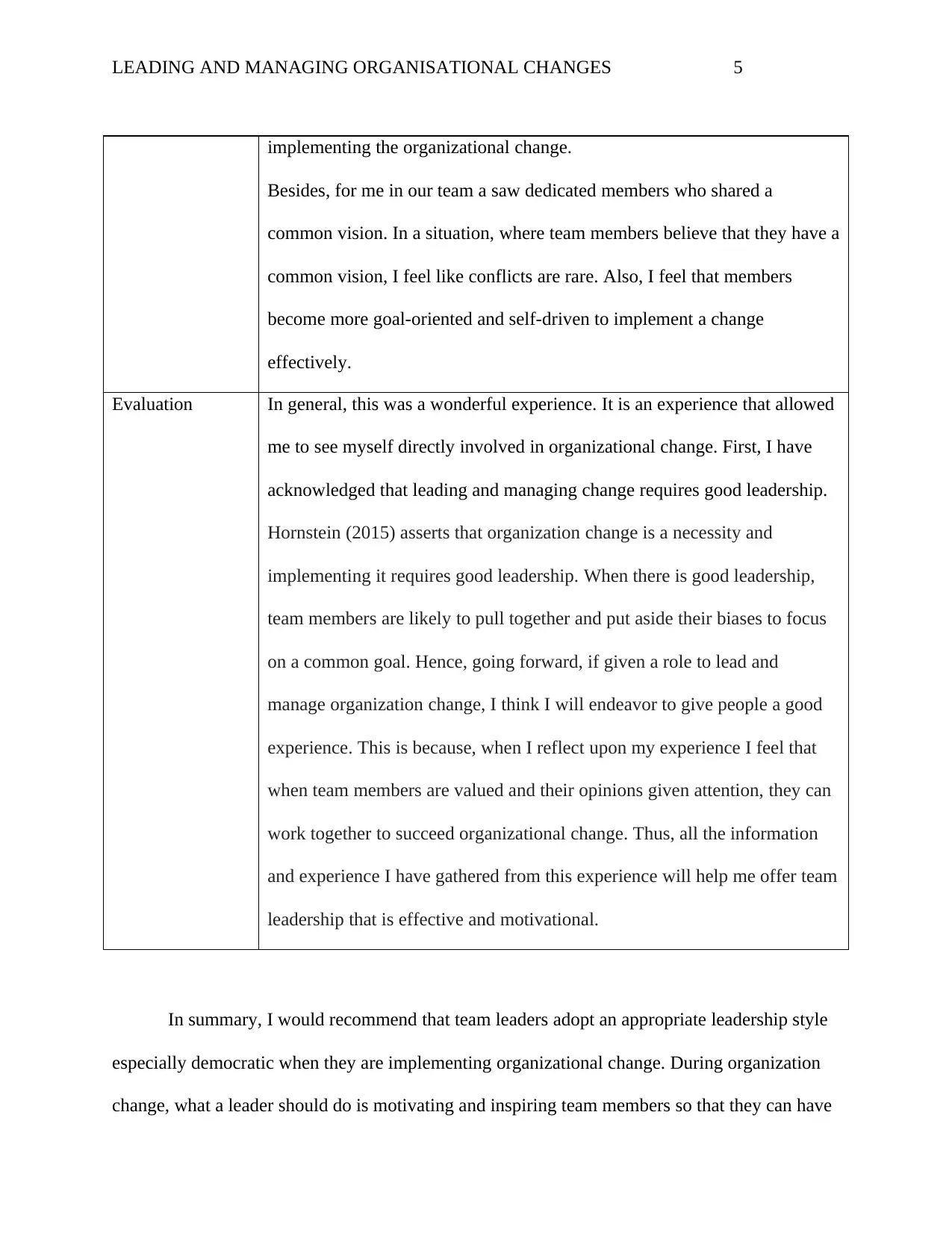
LEADING AND MANAGING ORGANISATIONAL CHANGES 5
implementing the organizational change.
Besides, for me in our team a saw dedicated members who shared a
common vision. In a situation, where team members believe that they have a
common vision, I feel like conflicts are rare. Also, I feel that members
become more goal-oriented and self-driven to implement a change
effectively.
Evaluation In general, this was a wonderful experience. It is an experience that allowed
me to see myself directly involved in organizational change. First, I have
acknowledged that leading and managing change requires good leadership.
Hornstein (2015) asserts that organization change is a necessity and
implementing it requires good leadership. When there is good leadership,
team members are likely to pull together and put aside their biases to focus
on a common goal. Hence, going forward, if given a role to lead and
manage organization change, I think I will endeavor to give people a good
experience. This is because, when I reflect upon my experience I feel that
when team members are valued and their opinions given attention, they can
work together to succeed organizational change. Thus, all the information
and experience I have gathered from this experience will help me offer team
leadership that is effective and motivational.
In summary, I would recommend that team leaders adopt an appropriate leadership style
especially democratic when they are implementing organizational change. During organization
change, what a leader should do is motivating and inspiring team members so that they can have
implementing the organizational change.
Besides, for me in our team a saw dedicated members who shared a
common vision. In a situation, where team members believe that they have a
common vision, I feel like conflicts are rare. Also, I feel that members
become more goal-oriented and self-driven to implement a change
effectively.
Evaluation In general, this was a wonderful experience. It is an experience that allowed
me to see myself directly involved in organizational change. First, I have
acknowledged that leading and managing change requires good leadership.
Hornstein (2015) asserts that organization change is a necessity and
implementing it requires good leadership. When there is good leadership,
team members are likely to pull together and put aside their biases to focus
on a common goal. Hence, going forward, if given a role to lead and
manage organization change, I think I will endeavor to give people a good
experience. This is because, when I reflect upon my experience I feel that
when team members are valued and their opinions given attention, they can
work together to succeed organizational change. Thus, all the information
and experience I have gathered from this experience will help me offer team
leadership that is effective and motivational.
In summary, I would recommend that team leaders adopt an appropriate leadership style
especially democratic when they are implementing organizational change. During organization
change, what a leader should do is motivating and inspiring team members so that they can have

LEADING AND MANAGING ORGANISATIONAL CHANGES 6
positive energy. It is positive energy that will help them support each other and share their
opinions about a change objectively.
positive energy. It is positive energy that will help them support each other and share their
opinions about a change objectively.
⊘ This is a preview!⊘
Do you want full access?
Subscribe today to unlock all pages.

Trusted by 1+ million students worldwide
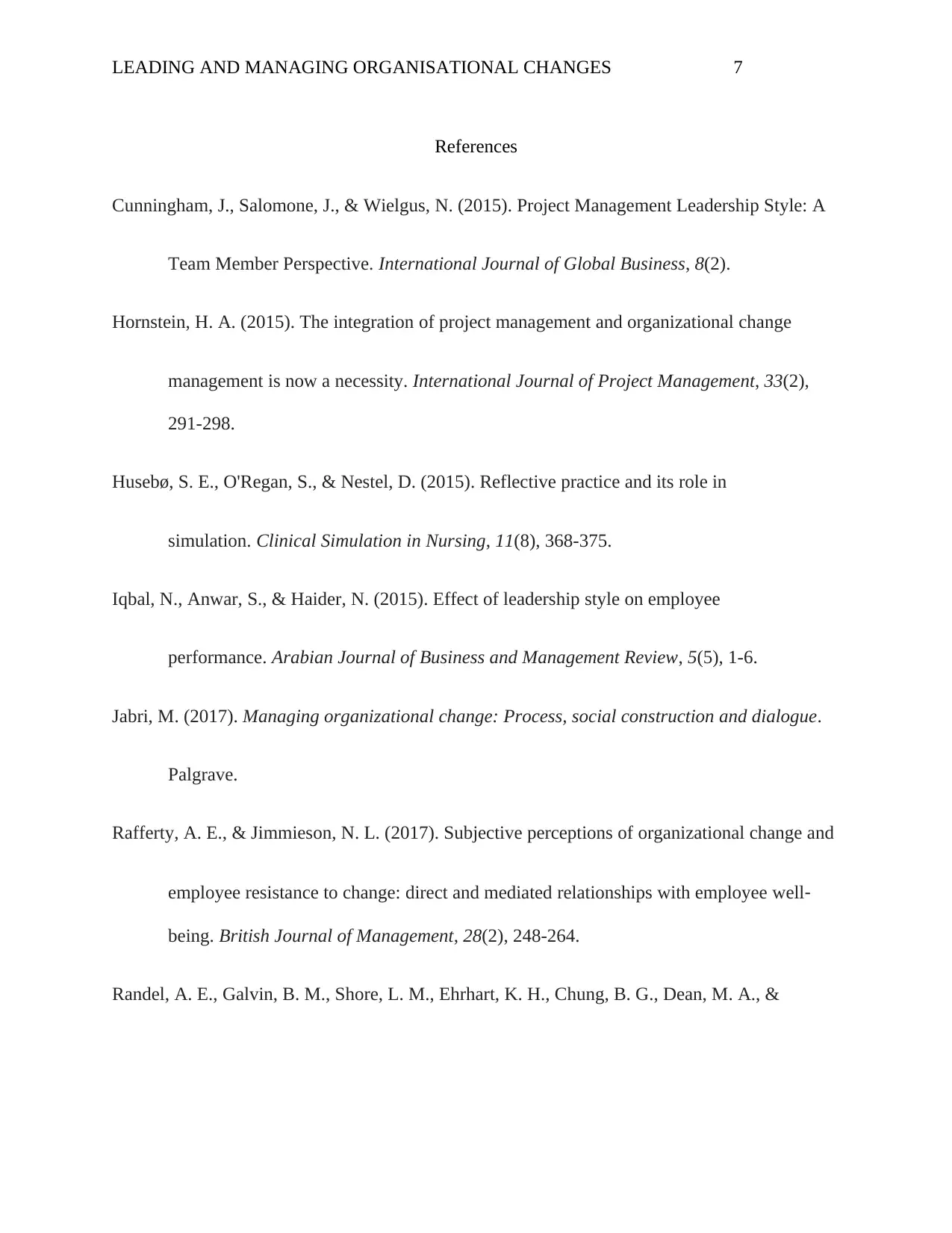
LEADING AND MANAGING ORGANISATIONAL CHANGES 7
References
Cunningham, J., Salomone, J., & Wielgus, N. (2015). Project Management Leadership Style: A
Team Member Perspective. International Journal of Global Business, 8(2).
Hornstein, H. A. (2015). The integration of project management and organizational change
management is now a necessity. International Journal of Project Management, 33(2),
291-298.
Husebø, S. E., O'Regan, S., & Nestel, D. (2015). Reflective practice and its role in
simulation. Clinical Simulation in Nursing, 11(8), 368-375.
Iqbal, N., Anwar, S., & Haider, N. (2015). Effect of leadership style on employee
performance. Arabian Journal of Business and Management Review, 5(5), 1-6.
Jabri, M. (2017). Managing organizational change: Process, social construction and dialogue.
Palgrave.
Rafferty, A. E., & Jimmieson, N. L. (2017). Subjective perceptions of organizational change and
employee resistance to change: direct and mediated relationships with employee well‐
being. British Journal of Management, 28(2), 248-264.
Randel, A. E., Galvin, B. M., Shore, L. M., Ehrhart, K. H., Chung, B. G., Dean, M. A., &
References
Cunningham, J., Salomone, J., & Wielgus, N. (2015). Project Management Leadership Style: A
Team Member Perspective. International Journal of Global Business, 8(2).
Hornstein, H. A. (2015). The integration of project management and organizational change
management is now a necessity. International Journal of Project Management, 33(2),
291-298.
Husebø, S. E., O'Regan, S., & Nestel, D. (2015). Reflective practice and its role in
simulation. Clinical Simulation in Nursing, 11(8), 368-375.
Iqbal, N., Anwar, S., & Haider, N. (2015). Effect of leadership style on employee
performance. Arabian Journal of Business and Management Review, 5(5), 1-6.
Jabri, M. (2017). Managing organizational change: Process, social construction and dialogue.
Palgrave.
Rafferty, A. E., & Jimmieson, N. L. (2017). Subjective perceptions of organizational change and
employee resistance to change: direct and mediated relationships with employee well‐
being. British Journal of Management, 28(2), 248-264.
Randel, A. E., Galvin, B. M., Shore, L. M., Ehrhart, K. H., Chung, B. G., Dean, M. A., &
Paraphrase This Document
Need a fresh take? Get an instant paraphrase of this document with our AI Paraphraser
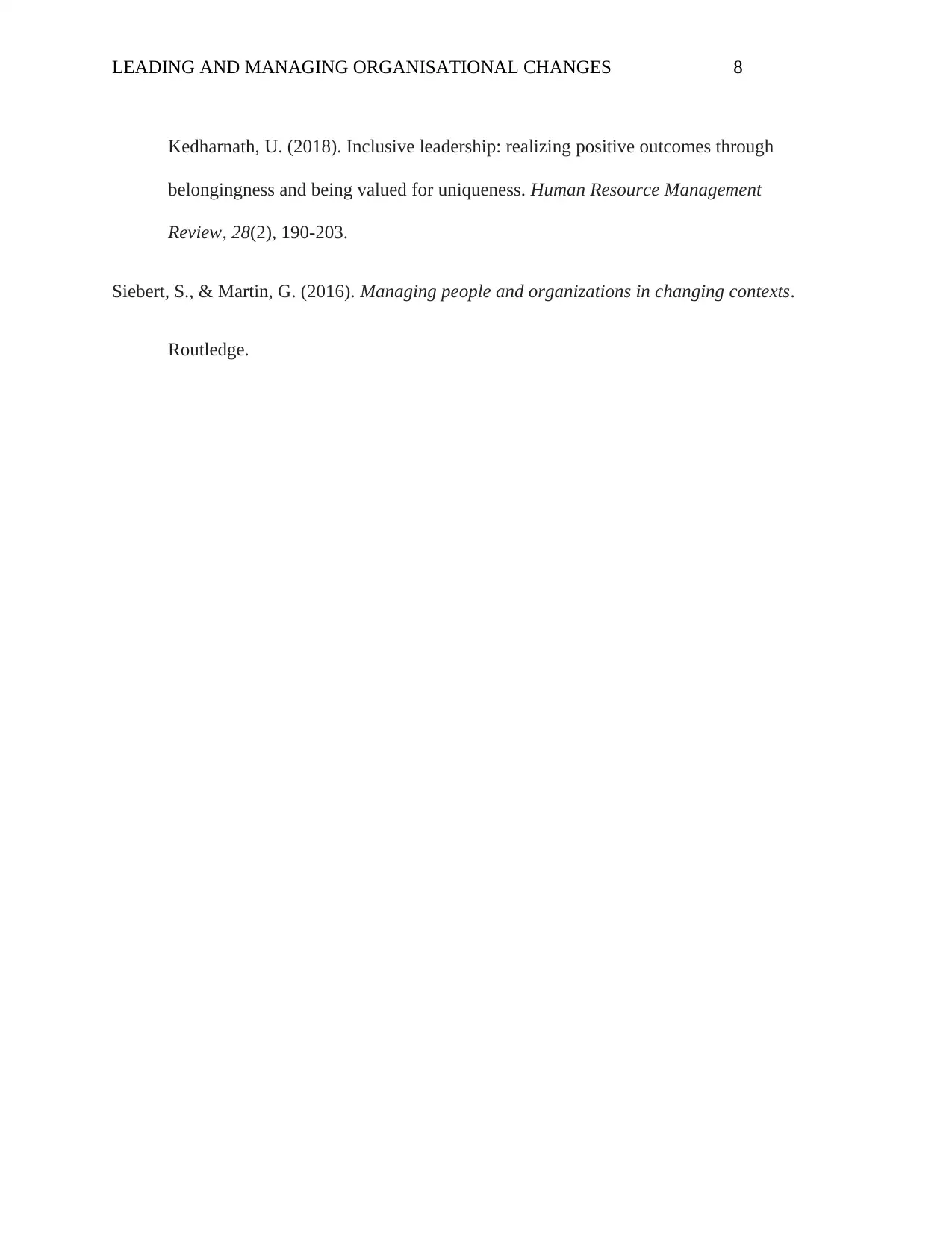
LEADING AND MANAGING ORGANISATIONAL CHANGES 8
Kedharnath, U. (2018). Inclusive leadership: realizing positive outcomes through
belongingness and being valued for uniqueness. Human Resource Management
Review, 28(2), 190-203.
Siebert, S., & Martin, G. (2016). Managing people and organizations in changing contexts.
Routledge.
Kedharnath, U. (2018). Inclusive leadership: realizing positive outcomes through
belongingness and being valued for uniqueness. Human Resource Management
Review, 28(2), 190-203.
Siebert, S., & Martin, G. (2016). Managing people and organizations in changing contexts.
Routledge.
1 out of 8
Related Documents
Your All-in-One AI-Powered Toolkit for Academic Success.
+13062052269
info@desklib.com
Available 24*7 on WhatsApp / Email
![[object Object]](/_next/static/media/star-bottom.7253800d.svg)
Unlock your academic potential
Copyright © 2020–2025 A2Z Services. All Rights Reserved. Developed and managed by ZUCOL.





